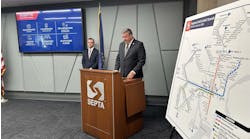OP-ED: MTA $68 billion 2025 - 2029 Five Year Capital Plan is dead on arrival in Albany, N.Y.
The good news is the recently released New York Metropolitan Transportation Authority (MTA) proposed $68 billion 2025 - 2029 Five Year Capital Plan allocates most funding to pay for safety and state of good repair versus system expansion projects. This would benefit the various MTA operating agencies, including the New York City Transit bus, subway (largest bus and subway systems in America) and Staten Island Railway, MTA Bus (the former New York City Department of Transportation's seven franchised bus operators whose routes, equipment and garages were acquired by MTA in 2005 and 2006) Long Island and Metro-North Rail Roads (the first and second largest commuter rail roads in America).
The wish list includes:
- $10.9 billion for new commuter rail cars.
- $9 billion for structural repairs.
- $7.8 billion for station improvements.
- $7.1 billion to bring more stations into compliance with the Americans With Disabilities Act (ADA).
- $5.4 billion for modernizing signals.
- $4 billion for power system improvements.
- $2 billion for maintenance facility upgrades.
- $1.7 billion for reconstruction of Grand Central Terminal Park Avenue structure.
- $1.1 billion for subway turnstiles to combat fare evasion.
- $800 million for environmental protection along the Metro-North Hudson Line.
- $700 million for defense against flooding due to storms.
There is also $2.75 billion allocated toward the $5.5 billion cost to construct the Brooklyn to Queens Interborough Light Rail Connector and $1.4 billion for electric buses.
Sadly, this plan will be dead upon arrival when it reaches the desks of New York Gov. Kathy Hochul and all 150 members of the New York State Legislature in coming months. Funding for this proposal would have to be included as part of the new state budget. It is due to be adopted on or before April 1, 2025.
Here's why this latest MTA Capital Plan, for financial reasons, is not worth the paper it is written on. Gov. Hochul claims she can find additional state and federal funding to make up for the missing $15 billion in congestion pricing from the current $51 billion 2020 - 2024 Five Year Capital Plan. She promises the same for making up the $33 billion shortfall in the proposed MTA $68 billion 2025 - 2029 Five Year Capital Plan. This leaves the MTA a record $48 billion shortfall in funding.
The MTA will receive $1.8 billion in annual formula grants supplemented by competitive discretionary grant program allocations from the Federal Transit Administration (FTA) in Fiscal Year 2024. Depending upon the level of national Congressional authorized and appropriated FTA funding levels, this might grow by one to two hundred million annually over each year of the next MTA five-year capital program.
The Federal Highway Administration has funding over several programs, including Congestion Mitigation Air Quality, Surface Transportation Program and others, which can be transferred to FTA to finance MTA capital projects. This funding source may also grow over the same time period. Contrary to the belief of Gov. Hochul, other than a handful of federal loans, as opposed to grant programs that provide hard cash, there are no other federal pots of gold to cover the missing $48 billion shortfall between the missing congestion pricing and 2025 - 2029 Five Year Capital Plan.
Under the MTA's numerous past Five Year Capital Plans, both New York City and New York State previously cut billions of their own respective financial contributions. They repeatedly had the MTA refinance or borrow funds to acquire scarce capital funding, formerly made up by hard cash from both city hall and Albany. On a bipartisan basis, since the 1980s, this included past Govs. Mario Cuomo, George Pataki, Elliot Spitzer, David Patterson, Andrew Cuomo and Hochul. Everyone insisted the MTA continue financing more and more of the capital program by borrowing.
Billions more are still needed from the state to make up for past cuts over previous decades. According to previous audits by New York State Comptroller Tom diNapoli, in future years, 23 percent of the annual MTA operating budget will go for covering debt service payments. By the end of this decade, this will continue to grow even higher.
Past governors and state legislatures have never provided any hard cash close to $48 billion in paying for previous MTA Five Year Capital Plan financial shortfalls. Don't be surprised in 2025 when both the governor and state legislature reduce the proposed $68 billion plan by billions. I predict it will end up some number in the $50 billion range.
When it comes to MTA financing, Gov. Hochul reminds me of the old cartoon character Wimpy. He was fond off saying, "I'll gladly pay you on Tuesday for a hamburger today," or in this case, $48 billion worth of MTA capital transportation projects that lack real money.
Both funding for and implementation of this most aggressive and expensive Five Year Capital plan in MTA history are lacking. A significant portion ($33 billion out of $68 billion) of the actual proposed funding sources for this plan are not available or even identified. Technical capacity to implement this new capital plan is also missing.
How will the MTA integrate and advance $15 billion in projects to be funded by future congestion pricing from the current $51 billion 2020 - 2024 Five Year Capital Plan? According to Gov. Hochul, the congestion pricing plan is on pause and not anticipated to start until some time between January 2025 and adoption of the next state budget on April 1, 2025.
There are billions in ongoing capital projects and programs not funded by congestion pricing— from the current $51 billion 2020 - 2024 Five Year Capital Plan, whose work will be carried over into the next Five Year Capital Plan, along with new projects and programs under the new $68 billion 2025 - 2029 Five Year Capital Plan.
The MTA did not provide any updated force account (its own track, signal maintainers and other specialized craft employees), track outage, procurement, construction schedules, routine asset maintenance schedules or staffing plans to validate any technical capacity to successfully manage all of the above within the next five years.
It is doubtful that construction will commence on the $5.5 billion Interboro Brooklyn to Queens Express Light Rail Connector within the next five years. The project has yet to be officially admitted into the FTA’s Capital Investment Grant New Starts Core Capacity program. The process from start to finish averages five years before FTA issues a Full Funding Grant Agreement.
Gov. Hochul instructed MTA Chairman Janno Lieber to do so over one year ago. The $2.75 billion in the new proposed MTA Five Year Capital plan is counting on currently non existent matching federal dollars to complete the funding package necessary for construction to start. Consideration of funding for this project should be postponed until the next MTA 2030 - 2034 Five Year Capital Plan.
One year ago, Lieber said MTA would look into the possibility of funding to extend the Second Avenue Subway west across 125th St. for $7.5 billion. It was the correct call not to include any funding for this third phase of Second Avenue Subway in the plan.
Allocation of funding for replacement of buses, subway and commuter rail cars, along with advancing closer to reaching a state of good repair for all other capital asset categories, should be a higher priority than any system expansion projects. Categories for each agency include such assets as existing bus, subway and commuter rail fleet, stations and elevators to meet ADA standards, escalators, track including switches, signals and interlockings, communications, line structures, including painting, protective netting on elevated structures and bridges, line equipment, including tunnel lighting, pump rooms and emergency exits, traction power, power substations, maintenance shops, yards, employee facilities and supervisory vehicles.
Funding for the $7.7 billion Second Avenue Subway Phase 2 and $5.5 billion Brooklyn/Queens Interboro Express Light Rail Connector would be better spent on progressing to a state of good repair for all operating agencies capital assets. The same holds true for placing Metro-North Rail Road's $3.1 billion Bronx East Penn Station Access project on hold. Forget about any consideration for the $7.5 billion Second Avenue Subway Phase 3 125th St. Crosstown Extension as well.
Any independent survey of riders would tell you an overwhelming majority of five million-plus pre-COVID-19 or four million-plus current MTA riders would prefer on time, safe, reliable bus, subway and commuter rail services at a fair price before system expansion. MTA will have to revise its proposed $68 billion dollar 2025 - 2029 Five Year Capital Plan to deal with a more realistic level of future funding availability.

Larry Penner
Larry Penner is a transportation advocate, historian and writer who previously served as a former director for the Federal Transit Administration Region 2 New York Office of Operations and Program Management. This included the development, review, approval and oversight for billions in capital projects and programs for New Jersey Transit, New York Metropolitan Transportation Authority, NYC Transit bus, subway and Staten Island Railway, Long Island and Metro North railroads, MTA Bus, NYCDOT Staten Island Ferry along with 30 other transit agencies in New York and New Jersey.






